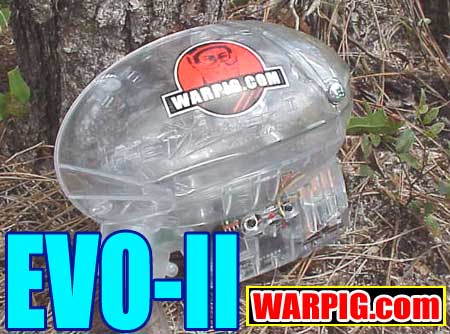  |
|
|
|
|
|
|
  |
|
|
|
|
|
|

What
do you think?
|

eVLution II The Next Evolution By Bill Mills ViewLoader’s eVLution loader turned a lot of heads when it was released. It featured an unconventional shape for a loader, a new lid style, and an impeller based system for driving paint out of the loader and into the feedneck instead of simply agitating the paintballs to break up a jam. For a review of the original eVLution, click here. Unfortunately the eVLution turned out to be an egg in more ways than just the shape. The loader developed a reputation for breaking paint or jamming at the most inopportune times, and for breaking its feedneck. It never gained popularity, even amongst ViewLoader sponsored teams. Enter the eVLution II, the redesigned version. WARPIG.com had the opportunity to try out a prototype version of the eVLution II in the winter of 2001/2002 and found it a favorable improvement performance wise. For a look at the prototype preview, click here. The production model eVLution II is not much different from the prototype, and holds definite improvements over the original.
Additionally the materials in the loader body have been changed. A number of players have e-mailed WARPIG.com reporting of original eVLution loaders breaking when shot. Instead of the plastic originally used on the eVLution, the body of the new model is injection molded from polycarbonate, the same rugged material used in goggle lenses.
Another problem that led to occasional misfeeds with the original eVLution stemmed from power drops with one or both of its 9 volt batteries bouncing loose from their spring contacts inside the battery bay. A very simple solution was found for this, a battery spacer is included with the loader. This spacer is a plastic shim that sits between the two batteries wedging them tight in their compartment. While the spacer does a great job of securing the batteries, the downside is that it makes them more difficult to remove. A pair of channel lock pliers is good to have on hand when it comes time to put in the next set of batteries.
The new impeller features six straight arms molded out of a white, flexible, rubber like material. Should a paintball become wedged below or near one of the arms, the arm flexes up and over the ball, rolling the ball like a bearing, rather than pressing harder into it and jamming.
In the field, the production models performed admirably, feeding a variety of paintguns without problems of skipped or chopped shots. Even using batches of softer older paint, the eVLution II fed without pinching or breaking. Occasionally the tone of the motor changed briefly while feeding older softer paint, possibly due to a change in resistance while an impeller arm flexed around a ball. Direct shots into the body of the eVLution II did not result in any cracks or signs of weakness in the body. The feed neck of the eVLution II is molded in two halves, without holes. The original eV, featured openings for the optical sensors and this added a weak point. On the eVLution II, the infrared beam simply passes right through the polycarbonate. While neither the production unit or prototype tested exhibited any problems, we have received a report of a broken feed neck on a production model eVLution II. ViewLoader's Terry Neumaster says that they have received a couple of breakage reports. Both were investigated and found to be original eVLution loaders on which a dealer had upgraded the impeller, and sold claiming they were eVLution II loaders. The telltale sign for customers to look for is the angle of the feedneck. An eVLution II will sit level in a paintgun. The eVLution II marks a definite step forward in reliability for the ViewLoader product line. It solves the chief technical problems suffered by its predecessor. Owing to the fact that its general appearance and name are so similar to the original, and poorly received eVLution, the eVLution II is likely to receive undue market resistance, and may never gain the popularity of the tried and true Revolution agitating loaders. Players would be well advised to consider the eVLution II on its own technical merits, rather than be led by the reputation of the original eVLution. |
| Copyright © 1992-2019
Corinthian Media Services. WARPIG's webmasters can be reached through our feedback form. All articles and images are copyrighted and may not be redistributed without the written permission of their original creators and Corinthian Media Services. The WARPIG paintball page is a collection of information and pointers to sources from around the internet and other locations. As such, Corinthian Media Services makes no claims to the trustworthiness or reliability of said information. The information contained in, and referenced by WARPIG, should not be used as a substitute for safety information from trained professionals in the paintball industry. |